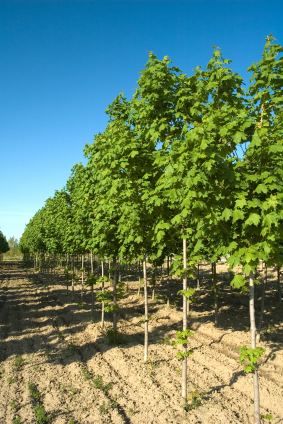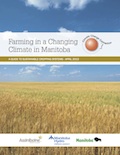 On this page, we deal with the following topics related to agroforestry:
On this page, we deal with the following topics related to agroforestry:
Click a link in the list above to jump to that topic on this page.
Trees can be extremely valuable resources to farmers, although over the last couple decades many trees have been torn down on the Prairies to enlarge fields.
When trees are grown together with crops and livestock, as an integrated production unit, numerous benefits can be observed. Trees have been shown to indirectly increase crop yields, improve soil and water quality, increase biodiversity, reduce greenhouse gas (GHG) emissions, and increase carbon (C) sequestration (1,2).
Trees, shrubs, or bushes act as natural buffers, filtering the air and water, reducing blowing wind, and even minimizing the spread of air-born crop diseases and pests (3). These plants can be easily incorporated onto your farm and are aesthetically pleasing as well.
Plant shelterbelts
Shelterbelts consist of one or more rows of strategically planted trees and/or bushes. Traditionally, shelterbelts were found around farmyards to shelter farm buildings and livestock, but they are also now used along highways or between fields. The trees help reduce wind, limit soil erosion and nutrient loss, control and trap blowing snow and conserve water (4).
Crop yields can increase with the use of shelterbelts. Trees physically protect young plants and reduce moisture losses by protecting crops from drying winds. A 20% yield increase was observed for alfalfa planted beside a shelterbelt (5).
Shelterbelts can also help fight climate change because they remove carbon dioxide (CO2) from the atmosphere and store it as carbon. Studies at the Agroforestry Development Centre, formerly known as the Prairie Farm Rehabilitation Administration (PFRA) Shelterbelt Centre, show that the leaves and branches of a mature poplar tree can store about 970 kg of CO2 (6). The leaves and branches alone can save the equivalent amount of driving a car approximately 4600 kilometres (7)! Tree roots are thought to store 50% to 75% more C than that stored above ground (8).
Despite the numerous benefits of shelterbelts, trees compete with crops for water and nutrients, and increase the amount of shade. With increasing equipment size and growing value of crops, Prairie farmers continue to push down shelterbelts to expand field size and increase land available for crop production.
Plant riparian buffers
Riparian buffers consist of trees, shrubs or grasses planted between cultivated crop land and a waterway, such as a river, pond, or dugout. The main benefits of these buffers are to filter surface run-off before it enters the water, to protect water edges from erosion, and to sequester C (9). Run-off may contain sediments, nutrients, and/or pesticides, which can be damaging to the water quality and the animals that live there (10). Without adequate buffering areas, nutrient and sediment filtering cannot take place which encourages the eutrophication (algal blooms) and sedimentation of local waterways (11).
Consider alley cropping
Alley cropping is a form of tree production that mixes trees with agricultural crops. The trees are planted in widely spaced rows with agricultural crops in alleys between the trees. The shelterbelts minimize soil erosion and nutrient loss, trap snow, and create warmer microclimates for crops (12,13).
Diversify into agro woodlots
Growing trees is becoming a popular way of bringing marginal land or small, irregular shaped sections of land into production. Fast growing wood crops, such as hybrid poplars, provide environmental benefits to the land, increasing soil organic matter and creating oxygen. Trees have high rates of nutrient uptake and can store large amounts of C over rotation lengths as short as 15 years. The Agro Woodlot Program of Manitoba recommends growing a combination of fast and slow growing trees to provide monetary benefits over a longer time (14).
Biomass from the trees can be used as timber or as an alternative fuel (bioenergy).






